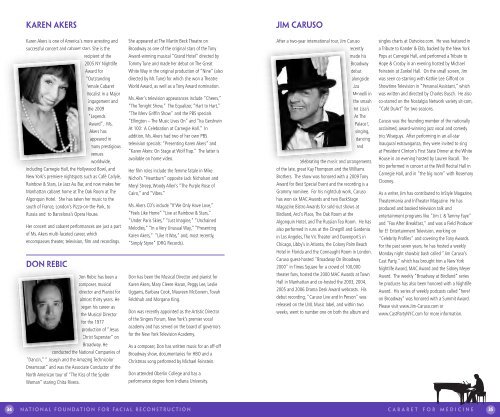National Foundati l Foundation for Fa cial Reco ... - Project Design
National Foundati l Foundation for Fa cial Reco ... - Project Design
National Foundati l Foundation for Fa cial Reco ... - Project Design
Create successful ePaper yourself
Turn your PDF publications into a flip-book with our unique Google optimized e-Paper software.
18 N AT I O N A L F O U N D AT I O N F O R FA C I A L R E C O N S T R U C T I O N<br />
lower jaw, and improve breathing and speech. This<br />
device improves a child’s appearance dramatically<br />
and can be done at later ages as well. Hand Surgery:<br />
Children with Aperts Syndrome are born with<br />
syndactyly (webbing or fusion of hands and feet).The<br />
hand surgeon separates fingers and can create a thumb<br />
from the toe. Nerve Creation:A static sling uses a leg<br />
muscle to enliven the immobilized face of a child with<br />
Mobius syndrome.Vascular Anomalies: Schlerotherapy<br />
can harden a vascular anomaly and inhibit growth,<br />
while laser can lighten a deep red hemangioma.<br />
A Nevus, a dark hairy patch, can be improved through<br />
tissue expansion and excision and can be done at<br />
any time. Orthodontics: Bone grafts replace bone<br />
in the gum if growth was inhibited by a cleft palate.<br />
Psychological: Children first become aware that they<br />
are different during this period. Other children may<br />
make fun of their face, and strangers may stare and<br />
ask insensitive questions in their presence.The So<strong>cial</strong><br />
Worker discusses finan<strong>cial</strong>, practical and emotional<br />
issues with parents including school entry, academic<br />
planning, educational needs, marriage conflicts and<br />
sibling issues.The psychologist encourages parents<br />
to speak to the school directly and may intervene<br />
personally on behalf of the child. She may work<br />
privately with the child or find a counselor in the<br />
family’s immediate area who can help the child<br />
through this period.<br />
What Care is Received in Latency?<br />
Ear <strong>Reco</strong>nstruction: At age 9 or 10, children with<br />
partial or mal<strong>for</strong>med ears can have Stage1 ear<br />
reconstruction. There is a huge change in a child<br />
when they no longer have to hide their de<strong>for</strong>med<br />
ear. Prosthetics: Prosthetic eyes, ears and other parts<br />
of the face can be created at this age but must be<br />
redone every two years because of fa<strong>cial</strong> growth and<br />
wear on the device. Pharyngial Flap: At 8-10 years,<br />
our cleft team orders a naso-endoscopy video to<br />
ascertain if a pharyngeal flap (a flap at the back of<br />
the throat to push against to create proper sounds)<br />
is necessary or if additional speech therapy will<br />
suffice. Hemangioma & Vascular intervention:<br />
Persistent anomalies may need numerous procedures,<br />
can defy medical intervention and cause appearance<br />
and functional problems. Orthodontic: Braces and<br />
palate expanders are used to remedy malocclusions<br />
(uneven bites). Complicated dental and orthodontic<br />
problems go hand-in-hand with almost all<br />
craniofa<strong>cial</strong> mal<strong>for</strong>mations. Psychological: The<br />
psychologist may suggest behavioral and/or cognitive<br />
testing <strong>for</strong> the child at this age. She interprets <strong>for</strong><br />
parents the lengthy neuro-psychology reports and<br />
may become the emotional lifeline to parents who<br />
are struggling at work, in their marriage, or with their<br />
child. The Senior So<strong>cial</strong> Worker continues to help<br />
parents find resources and navigate the healthcare<br />
system, often intervening in foster care situations,<br />
abuse cases, housing, legal and visa issues not<br />
specific to our patient population.<br />
What Care is Received in Adolescence?<br />
Secondary Surgeries: Final major surgical repairs<br />
are done at this time if the child has reached full<br />
skeletal growth. Children with multiple anomalies<br />
go through a surgery every few years during this<br />
period. Ear <strong>Reco</strong>nstruction: The second stage of ear<br />
reconstruction is done at this age. Orthodontics:<br />
Orthodontics continues with retainers, braces, bone<br />
grafts and dental implants. Psychological: The<br />
teenage years are a very painful, sensitive time <strong>for</strong><br />
a child that has to wait until his/her face is fully<br />
matured <strong>for</strong> final reconstruction. Children can<br />
gain weight, refuse to attend school and become<br />
increasingly isolated, uncommunicative and<br />
depressed. Even if schoolmates have been inclusive in<br />
earlier years, they will noticeably separate themselves<br />
from a child with a fa<strong>cial</strong> difference as they concentrate<br />
more intently on their so<strong>cial</strong> lives. The Psychologist is<br />
able to differentiate normal “teen” behavior from<br />
aberrant behavior that is likely the result of the child’s<br />
fa<strong>cial</strong> difference. She may speak directly to the school<br />
if the child is having difficulties emotionally or<br />
academically or suggest ongoing local counseling,<br />
working closely with that counselor to explain that<br />
even though the child does not have a non life<br />
threatening disease, their lives are dramatically<br />
impacted nevertheless.<br />
What Care is Received in Early Adulthood?<br />
Final Orthodontics: a last secondary surgery or major<br />
fa<strong>cial</strong> distraction is able to be scheduled. The face<br />
must be fully developed be<strong>for</strong>e a final skeletal<br />
reconstruction can be lasting. Psychological: The<br />
psychologist may step in to keep a young person<br />
feeling positive about their future, the So<strong>cial</strong> worker<br />
will help with job counseling and finan<strong>cial</strong> aid, and<br />
the genetic counselor may be called in at this time<br />
to talk to the teenager about his/her chances of<br />
passing on the anomaly to his/her child.<br />
C A B A R E T F O R M E D I C I N E<br />
19


